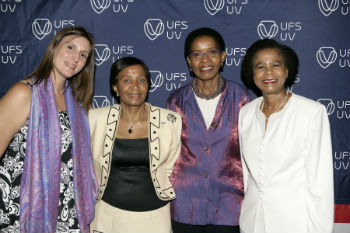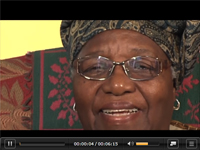“You cannot find Ubuntu in a culture of dominance” – Dr Mamphela Ramphele during second Leah Tutu Gender Symposium
 From the left are: Samantha van Schalkwyk, Zanele Mbeki, Prof Pumla Gobodo-Madikizela and Dr Mamphela Ramphele.
Photo: Johan Roux |

Video message from Mrs Leah Tutu
Session 1: Keynote address by Dr Mamphela Ramphele
Ndiyindoda! Yes, you are a man
Session 2: Professor Robert Morrell from the University of Cape Town
South African Gender Studies: Setting the context
Session 3: How can we engage young men to act against violence against women?
Panel discussion by Lisa Vetten (Wits Institute for Social and Economic Research), Despina Learmonth (Psychology Department, University of Cape Town) and Wessel van den Berg (Sonke Gender Justice)
Session 4: Professor Pumla Gobodo-Madikizela
Self-defence as a strategy for women’s resistance: Reflections on the work of Susan Brison
Engaging men to act against gender-based violence in the Southern African context.
This was the theme of the second International Leah Tutu Symposium, hosted by the Gender Initiative of Trauma, Forgiveness and Reconciliation Studies of the University of the Free State (UFS) on Tuesday 24 February 2015.
What does it mean to be man? How can men become active in the fight against gender-based violence? And when does one say: enough is enough? Questions like these set the tone as highly-respected individuals such as Dr Mamphela Ramphele, Prof Rob Morrell, Lisa Vetten and Andy Kawa took to the stage in the Odeion on the Bloemfontein Campus.
Leah Tutu
Unfortunately, Mrs Leah Tutu could not attend this year’s event, but she still managed to send sparks of wit and insight into the auditorium. In her video message, Mrs Tutu referred to the fact that our country has “consigned discriminatory legislation to the rubbish bin of the past”, but we continue to inhabit a divided society.
“We have a constitution and bill of rights that should have sounded the death knell for patriarchy. But women are unsafe across the land,” Mrs Tutu said. “Our freedom cost too much to be left out in the rain,” she urged.
Ndiyindoda! Yes, you are a man
In Dr Ramphele’s keynote address, “Ndiyindoda! Yes, you are a man”, she scrutinised the dominant masculinity model that has supported an alpha-male mentality for millennia. A mentality that celebrates dominance, power and control – where the winner takes it all. How then, can we expect our young boys to embrace the value system of a human rights culture?
“Gender equality is at the heart of our constitutional democratic values. Yet, our society continues to privilege and celebrate the alpha male as a masculinity model,” Dr Ramphele said. This dissonance can only produce conflict and violence.
We encourage our young men to be gentle, communicative, caring people who show their emotions. And when they do, what do we as women do? Do we encourage them?
“Or do we join those who call them wimps, moffies, sissies? How do we respond when they are ridiculed?” Dr Ramphele asked. Are we, as mothers, fathers and grandparents willing to socialise our children to acknowledge a diversity of masculinities as equally valid in our society?
The new man and the new woman of the 21st century need to be liberated from the conflict-ridden dominant masculinity model. They need to be able to shape their identity in line with a value system of human rights as enshrined in our constitution.
Perhaps Dr Ramphele’s message could be summed up by one sentence: You cannot find Ubuntu in a culture of dominance.